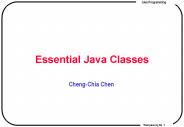Classes, Encapsulation, Methods and Constructors (Continued) - PowerPoint PPT Presentation
Title:
Classes, Encapsulation, Methods and Constructors (Continued)
Description:
Block Tags for Classes. At the class level, you must include these block tags with data (each on a separate line) ... In-Line tags are always included inside ... – PowerPoint PPT presentation
Number of Views:55
Avg rating:3.0/5.0
Title: Classes, Encapsulation, Methods and Constructors (Continued)
1
Classes, Encapsulation, Methods and Constructors
(Continued)
- Class definitions
- Instance data
- Encapsulation and Java modifiers
- Method declaration and parameter passing
- Constructors
- Method Overloading
- Reading for this lectureLL, 4.1-4.5 App E
2
Method Declarations
- A method declaration specifies the code that will
be executed when the method is invoked (called) - When a method is invoked, the flow of control
jumps to the method and executes its code - When complete, the flow returns to the place
where the method was called and continues - The invocation may or may not return a value,
depending on how the method is defined
3
Method Control Flow
- If the called method is in the same class, only
the method name is needed
4
Method Control Flow
- The called method is often part of another class
or object
5
Method Header
- A method declaration begins with a method header
char calc (int num1, int num2, String message)
method name
parameter list
The parameter list specifies the type and name of
each parameter The name of a parameter in the
method declaration is called a formal parameter
return type
6
Method Body
- The method header is followed by the method body
char calc (int num1, int num2, String message)
int sum num1 num2 char result
message.charAt (sum) return result
sum and result are local data They are created
each time the method is called, and are destroyed
when it finishes executing
The return expression must be consistent with the
return type
7
Local Data
- Local variables can be declared inside a method
- The formal parameters of a method are also local
variables when the method is invoked - When the method finishes, all local variables are
destroyed (including the formal parameters) - Keep in mind that instance variables, declared at
the class/object level, exist for as long as the
object exists
8
The return Statement
- The return type of a method indicates the type of
value that the method sends back to the caller - A method that does not return a value has a void
return type - A return statement specifies the value that will
be returned upon completion of the method code - return expression
- Its expression must conform to the return type
9
Parameters
- When a method is called, the actual parameters in
the call are copied into the formal parameters in
the method header
ch obj.calc (25, count, "Hello")
10
Objects as Parameters
- Another important issue related to method design
involves parameter passing - Parameters in a Java method are passed by value
- A copy of the actual parameter (the value passed
in) is stored into the formal parameter (in the
method header) - Therefore passing parameters is similar to an
assignment statement - When an object is passed to a method, the actual
parameter and the formal parameter become aliases
of each other
11
Passing Objects to Methods
- What a method does with a parameter may or may
not have a permanent effect (outside the method) - See ParameterTester.java (page 333-334)
- See ParameterModifier.java (page 335)
- See Num.java (page 336)
- Note the difference between changing the internal
state of an object versus changing the value of a
reference to point to a different object
12
Method Overloading
- Method overloading is the process of giving a
single method name multiple definitions - If a method is overloaded, the method name is not
sufficient to determine which method is being
called - The signature of each overloaded method must be
unique - The signature includes the number, type, and
order of the parameters
13
Method Overloading
- The compiler determines which method is being
invoked by analyzing the parameters
float tryMe(int x) return x .375 float
tryMe(int x, float y) return xy
14
Method Overloading
- The println method is overloaded
- println (String s)
- println (int i)
- println (double d)
- and so on...
- The following lines invoke different versions of
the println method - System.out.println ("The total is")
- System.out.println (3)
15
Method Overloading
- The return type of the method is not part of the
signature - Overloaded methods cannot differ only by their
return type - Constructors can be overloaded and often are
- Overloaded constructors provide multiple ways to
initialize a new object
16
Accessors and Mutators
- A class usually provides methods to indirectly
access and modify the private data values - An accessor method returns the current value of a
variable - A mutator method changes the value of a variable
- The names of accessor and mutator methods take
the form getX and setX, respectively, where X is
the name of the value - They are sometimes called getters and setters
17
Mutator Restrictions
- The use of mutators gives the class designer the
ability to restrict a clients options to modify
an objects state - A mutator is often designed so that the values of
variables can be set only within particular
limits - For example, the setFaceValue mutator of the Die
class should restrict the value to the valid
range (1 to MAX)































